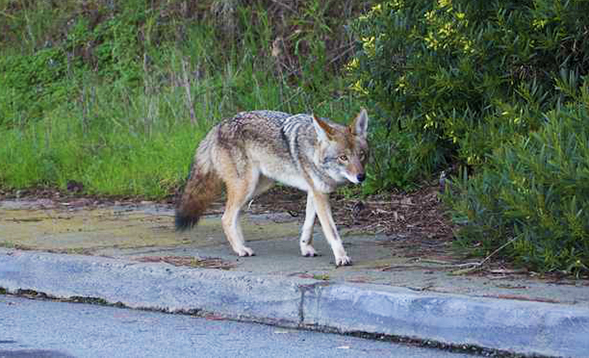The Plight of Furry City Slickers
SDSU hosted and participated in a conference exploring how humans and urban wildlife can coexist.

Humans aren’t the only creatures that call cities and their suburbs home. A host of wild animals have adapted—some better than others—to urban life, and understanding their adaptations can make city life safer for both humans and wildlife.“Stakeholders and planners need to recognize this is how the process works and use data-driven, quantitative analytics to make decisions that benefit the stakeholders as well as wildlife.”
Last week, San Diego State University hosted the International Urban Wildlife Conference where biologists, ecologists and city planners met to share their research and insights into how various species have come to cope with living in close proximity to humans, as well as the best ways to protect species endangered by habitat loss.
Researchers from dozens of universities and institutions presented on topics like native bee preservation, the effects of urban noise and light pollution on animals, the role of citizen science in tracking population trends, interspecies disease transmission and how coyotes have become so wildly successful at living in urban environments. The conference’s organizing committee, which included SDSU biologists Rebecca Lewison and Megan Jennings, also arranged a reception at the San Diego Zoo and field trips to San Diego Bay, the Tijuana Estuary, Cabrillo National Monument and several wildlife crossings installed across the county.
Several researchers and graduate students from SDSU were among the conference presenters. Biologist Heather Marschalek described her work looking at how urbanization is impacting the populations of grassland songbirds. Most research into these birds has been conducted in the Midwest and the Great Plains, leaving the southwest region relatively neglected. Marschalek has found that the biggest factor influencing grassland songbird population in San Diego County isn’t encroaching urbanization, but loss of native groundcover.
“These birds are really seeking the native cover to build their nests,” she said. “It shows the value of even small grassland patches in urban areas. They’re potentially very important to these species, but they really need native vegetation.”
Michael Anguiano, a wildlife consultant at the engineering firm AECOM, presented research he conducted as an SDSU graduate student more than 10 years ago. The work, published in 2015 in the Journal of Herpetology, focused on how habitat fragmentation due to housing and retail development affects local snakes. He found that one snake in particular, the California kingsnake, manages to thrive under fragmented conditions while other snakes do not. Tracking their movements using radio transmitters, he learned that kingsnakes use short, frequent movements, often traveling fewer than 40 meters per day. They also appear to tolerate their ranges overlapping with other snakes. These traits enable them to live comfortably in relatively small parcels of undisturbed land.
Natalie Goddard, a graduate student studying evolutionary biology at SDSU, focused on creatures much, much smaller than birds or snakes: tiny crustaceans known as fairy shrimp that live exclusively in inland waterholes known as vernal pools. In 1997, they were listed as a federally endangered species, as development has led to the loss of about 95 percent of the vernal pools in San Diego County. Management strategies are crucial for protecting these delicate shrimp, and Goddard studied how activity on Marine Corps Air Station Miramar—which hosts the largest number of undisturbed vernal pools in the county—affects fairy shrimp populations. Studying the genetic makeup of the shrimp in various pools, she determined that trucks crossing the station along access roads sometimes introduce parasitic species into these pools or even different species of fairy shrimp, endangering their genetic purity.
SDSU’s Jennings spoke at a special session exploring how governments, private land owners and conservationists can establish or preserve corridors connecting fragmented environments that are critical to wildlife movement. Her work, focusing on how deer, coyotes, bobcats, raccoons, opossums and others cross State Route 67 in East County, underscores the need for land planning to be data-driven and flexible. Jennings collaborates with the California Department of Transportation to determine whether larger drainage culverts would allow more animals to cross safely beneath the busy highway.
“Science evolves and plans need to be flexible enough to fit new data,” she said, adding that humans’ land use needs change over time and climate change will alter which habitats animals use. “Stakeholders and planners need to recognize this is how the process works and use data-driven, quantitative analytics to make decisions that benefit the stakeholders as well as wildlife.”



